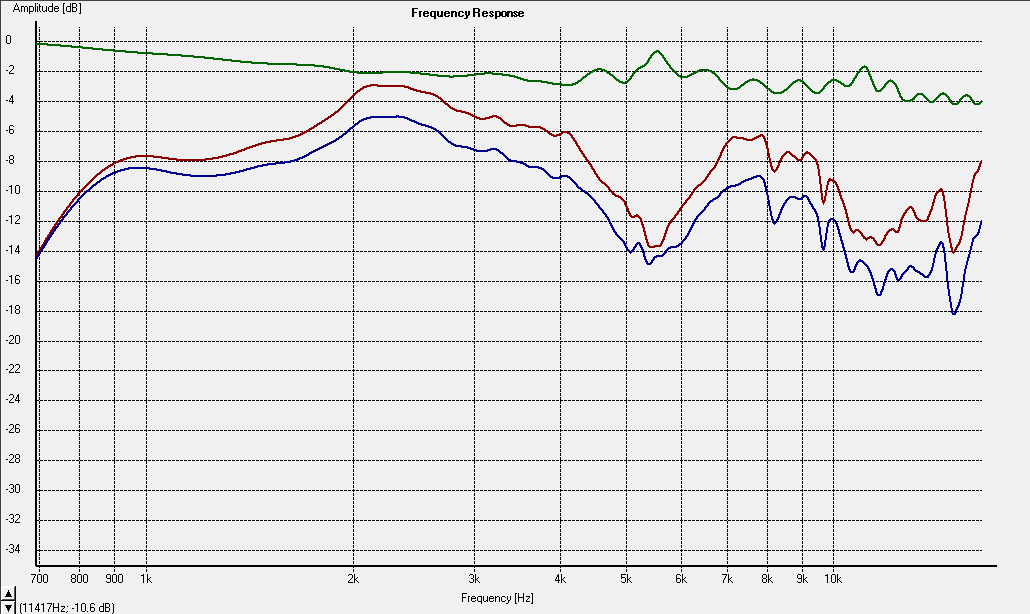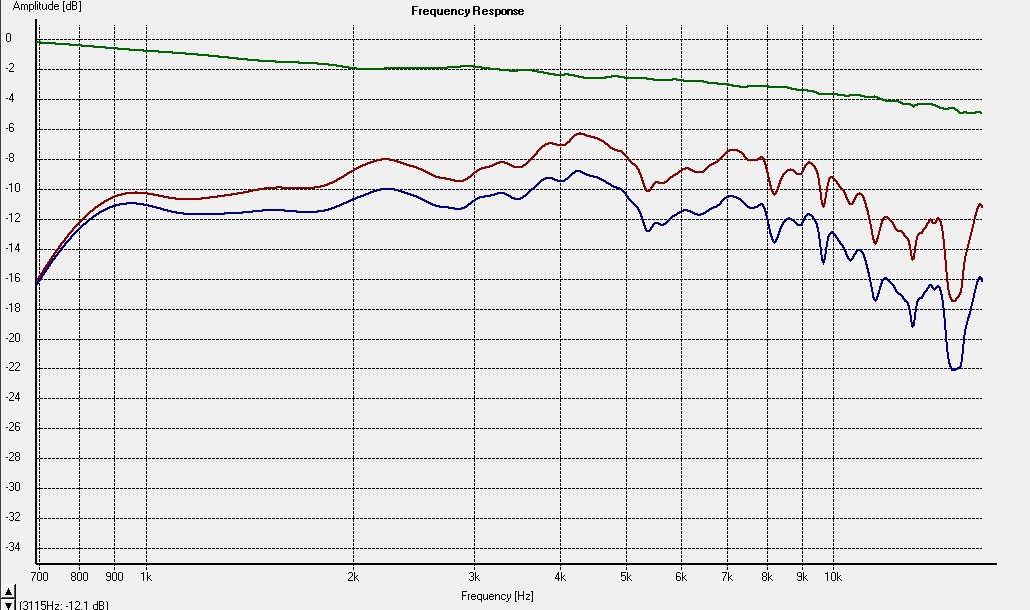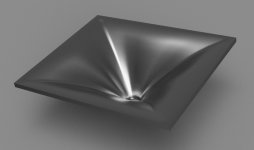Of course, it's the spatial variation that prevents the correction, as we both just said. Otherwise, for a one-dimensional case everything is correctable via a FIR filter that can manipulate amplitude and phase responses independently. For example, a crossover-induced excess phase can be corrected for at least one point in space, and for a coaxial system it could be corrected almost perfectly everywhere, I believe. The queston is why would anyone do that if it's not really audible - maybe marketing as it brings no additional cost once you have a FIR DSP in place.Oh, what kind of non-minimum phase system issues do you think are also correctable?
I'm having a hard time picturing any...(other than maybe simple time delays for geometric offsets, which even then are only good corrections to single observation points)
Last edited:
The trouble is it may be audible even if very low level relative to the "fundamental". The same as with nonlinear distortion.Yes, I'd like to know that S/N ratio too...what are we talking about, how significant?
At least that's what I would assume, or feel one should assume. But maybe it's not and the whole "honk problem" is in fact something completely different. What do we actually know?
Last edited:
Dammit I should be sleeping...you guys have the best convo...I did the best that I could to get the one guy on the Facebook mastering engineer group to take measurements of his Strauss...he didn’t even know how nor would he likely if he had measuring mic
I got banned for nine days fighting off other mastering engineers trying to gaslight my loudspeaker design knowledge, though rudimentary compared to some of you here...spades compared to that group of people minus a select few who helped provide validity to myself
After the ban I tried more using nicer words for the trolls who were mad because I bad mouthed the Dutch 8c previously based on price. The Strauss owner told tales of how Mr Strauss flew in, installed the speakers set up the room etc etc...for 64000 I’d expect a plane ticket was a pebble in the pond lol.... if B&H had a return policy I’d buy a single one, take measurements and return it.... I told the group if a person tells you they have the best speaker in the world it just cost 64,000 but they aren’t willing to share the measurements in full disclosure, run.... some of the other notable comments were why do you want the measurements for a $64,000 speaker if you can’t afford a set (I told I spent 10 on a comparable system and likely will put the other 50 on the nasdaq index ... others said the measurements are useless because that’s not how speakers work in the real world..... One idiot tried to tell me that I can’t take measurements at 1 inch from the driver because the room still has influence there… He was the one talking big **** about kippel measurements and he didn’t even know that REW measurements were gated
I have lost my soft spot for music mastering engineers (except for people like Mitchba and others here =)...at this rate software will replace them much sooner than anticipated... I think maybe sound engineering for cinema might be more my aptitude, I wonder if I can do this out of a basement
I employ all of you to steal all of the music mastering engineers jobs, I don’t see why the ones in that group would be much competition....I apologize for suggesting we bring mastering engineers in house into loudspeaker design for the same reason car audio is not allowed on the Martin king group.
Regarding HOM analysis....is the spectral cumulative decay useful?
I got banned for nine days fighting off other mastering engineers trying to gaslight my loudspeaker design knowledge, though rudimentary compared to some of you here...spades compared to that group of people minus a select few who helped provide validity to myself
After the ban I tried more using nicer words for the trolls who were mad because I bad mouthed the Dutch 8c previously based on price. The Strauss owner told tales of how Mr Strauss flew in, installed the speakers set up the room etc etc...for 64000 I’d expect a plane ticket was a pebble in the pond lol.... if B&H had a return policy I’d buy a single one, take measurements and return it.... I told the group if a person tells you they have the best speaker in the world it just cost 64,000 but they aren’t willing to share the measurements in full disclosure, run.... some of the other notable comments were why do you want the measurements for a $64,000 speaker if you can’t afford a set (I told I spent 10 on a comparable system and likely will put the other 50 on the nasdaq index ... others said the measurements are useless because that’s not how speakers work in the real world..... One idiot tried to tell me that I can’t take measurements at 1 inch from the driver because the room still has influence there… He was the one talking big **** about kippel measurements and he didn’t even know that REW measurements were gated
I have lost my soft spot for music mastering engineers (except for people like Mitchba and others here =)...at this rate software will replace them much sooner than anticipated... I think maybe sound engineering for cinema might be more my aptitude, I wonder if I can do this out of a basement
I employ all of you to steal all of the music mastering engineers jobs, I don’t see why the ones in that group would be much competition....I apologize for suggesting we bring mastering engineers in house into loudspeaker design for the same reason car audio is not allowed on the Martin king group.
Regarding HOM analysis....is the spectral cumulative decay useful?
Last edited:
Yeah, don't do that - taking measurements will steal their soul.I did the best that I could to get the one guy on the Facebook mastering engineer group to take measurements of his Strauss...he didn’t even know how nor would he likely if he had measuring mic
I think CSD is more suitable to reveal resonant behaviour than excess phase features. HOMs and diffractions are delayed but not resonant per se. Honestly I'm not sure how even a very strong HOM would look like in a CSD plot, or whether it would show at all. How do HOMs affect amplitude response? CSD is only amplitude so anything not affecting amplitude response won't show.Regarding HOM analysis....is the spectral cumulative decay useful?
Last edited:
(a) causal world and HOM hunting
Mark,
in a causal world (outcomes happen after inputs) non-minimum phase systems are exactly those lacking a stable inverse. So it's impossible to perfectly correct (invert) such systems.
As you know well, digital systems, in particular FIR filters can be acausal, so you can invert even "impossible" systems, except near true zeros of the system response function, due to finite SNR. One of the reasons that making correction filters is an art.
The SNR question is a good one.
What does a HOM look like in a response function? I'm not sure that we've seen the math needed to predict HOMS other than the HOM spectrum in Earl's work.
My impression (OK, guess) is that they should show relatively subtle amplitude variations (few dB?) and moderately high Q. Why? Other than a guess, this is based on the hypothesis that "Earl's foam" (with which I'm familiar) makes a difference. It's not very lossy at the lower HOM frequencies, so the effect on other than high Q modes would be subtle, even with the geometrical factor (HOM sound has a longer path). Also, the way hearing works, I doubt that a broad feature would attract the kind of attention that HOMs can -always presuming I know what I'm hearing, which I still doubt due to lack of confirmation by measurement.
HOMs (higher order spatial modes) are guaranteed to have a different spatial distribution than the fundamental suggesting they may well be non-minimum phase, except perhaps for a restricted measurement axis or region for a given HOM.
To seek to measure HOMS, frequency smoothing needs to be avoided - the measurement window will have to be quite long to get enough the frequency resolution, and as we know that's an nightmare. I've tried with Holm, but never got anywhere close to a convincing result. I've been bemused for a decade that nobody else has either.
Ken
Yes, I'd like to know that S/N ratio too...what are we talking about, how significant?
Oh, what kind of non-minimum phase system issues do you think are also correctable?
I'm having a hard time picturing any...(other than maybe simple time delays for geometric offsets, which even then are only good corrections to single observation points)
Mark,
in a causal world (outcomes happen after inputs) non-minimum phase systems are exactly those lacking a stable inverse. So it's impossible to perfectly correct (invert) such systems.
As you know well, digital systems, in particular FIR filters can be acausal, so you can invert even "impossible" systems, except near true zeros of the system response function, due to finite SNR. One of the reasons that making correction filters is an art.
The SNR question is a good one.
What does a HOM look like in a response function? I'm not sure that we've seen the math needed to predict HOMS other than the HOM spectrum in Earl's work.
My impression (OK, guess) is that they should show relatively subtle amplitude variations (few dB?) and moderately high Q. Why? Other than a guess, this is based on the hypothesis that "Earl's foam" (with which I'm familiar) makes a difference. It's not very lossy at the lower HOM frequencies, so the effect on other than high Q modes would be subtle, even with the geometrical factor (HOM sound has a longer path). Also, the way hearing works, I doubt that a broad feature would attract the kind of attention that HOMs can -always presuming I know what I'm hearing, which I still doubt due to lack of confirmation by measurement.
HOMs (higher order spatial modes) are guaranteed to have a different spatial distribution than the fundamental suggesting they may well be non-minimum phase, except perhaps for a restricted measurement axis or region for a given HOM.
To seek to measure HOMS, frequency smoothing needs to be avoided - the measurement window will have to be quite long to get enough the frequency resolution, and as we know that's an nightmare. I've tried with Holm, but never got anywhere close to a convincing result. I've been bemused for a decade that nobody else has either.
Ken
In the past I measured the effect of the foam plug on my 12" OSWGs (quite a lossy one in fact). I still don't know what exactly to take from that.
Unfortunately I probably won't find the original data anymore. I could try some more analysis.
On axis (green is the difference):

30 deg off-axis:

Unfortunately I probably won't find the original data anymore. I could try some more analysis.
On axis (green is the difference):
30 deg off-axis:
Last edited:
That's more or less an H100 clone, which is definitely not a very bad horn.
I'd recommend to buy an original H100 though, because of the material properties, the surface finish and roundovers.
Looking forward to your findings nonetheless.
It is certainly interesting to investigate to what extent the - scientifically demonstrable disadvantages - of a diffraction slot actually influence the (midfield) rendering.
The 2380A should be an example of a "bad horn," but it is precisely this one that is used in, what many professionals consider, one of the very best studio monitors ever made.
The maker (Jürgen Strauss) is extremely focused on impulse / phase and radiation characteristics.
According to the pro's in the recording business, despite the analog technology, the MF-2 is superior to it's (FIR optimised) competitors.
Also interesting is Strauss's view that separate subs are a big no-go in a stereo studio setup.
I heard the Strauss Flagship... i can't understand why it is so famous... my personal explaining : "lobbying"
A studio monitor is often un-remarkable, in opposition to voiced speakers, which is a matter of taste...
Of course, it's the spatial variation that prevents the correction, as we both just said. Otherwise, for a one-dimensional case everything is correctable via a FIR filter that can manipulate amplitude and phase responses independently. For example, a crossover-induced excess phase can be corrected for at least one point in space, and for a coaxial system it could be corrected almost perfectly everywhere, I believe. The queston is why would anyone do that if it's not really audible - maybe marketing as it brings no additional cost once you have a FIR DSP in place.
Yep. And i was being a little brain dead saying i couldn't think of any non-minimum phase examples that can be corrected. Not sure how I forgot about IIR xovers (i guess because i rarely use them).
I for one am convinced eliminating phase wrap from xovers is audible (by using linear phase xovers).
Ime/imo, Factors that increase the audibility are:
increased number of ways (3-way, 4-way etc),
increased order of xovers,
and the lower the xover frequency (the more the audibility).
IOW, phase wrap matters...to my ears anyway🙂
I've also found it most often helps off-axis meas.
Why do you think it's neutral?
I have not heard Strauss so that is not my point, and I don't believe you have neither? I do have heard and own Genelec monitors, that's where I come from.
Neutral for me is flat response, as I wrote, voiced speakers are not flat, ie taste...
If you are talking about drivers colouring the sound, I'm out!
What I also own is 2380 horns, can't say I'm terrified about the noice they make, ignorant as I am😀
If it does you do more than the phase linearization. By definition, if applied to an input signal to speakers, it can't change the radiation pattern. So it's difficult to judge on audibility of linear vs non-linear phase response in such case if some other effects take place.I've also found it most often helps off-axis meas.
Last edited:
To seek to measure HOMS, frequency smoothing needs to be avoided - the measurement window will have to be quite long to get enough the frequency resolution, and as we know that's an nightmare. I've tried with Holm, but never got anywhere close to a convincing result. I've been bemused for a decade that nobody else has either.
Ken
Hi Ken,
Many good points in your post, that match my thoughts.
I've tried to measure HOMs and/or mouth reflections in the time domain, using a coax CD on horns. Using one section of the CD as the source and the other as a microphone.
I ping the source section with a true one-sample Dirac pulse and then look for reflections in the impulse (after the main pulse which i know is from time of flight between the two sections).
I've seen reflections that appear looking at their delays, to be from the horn back into the CD. Still pondering it all...need to pick up the experiments again....
Like you say, not easy 🙂
I've also tried to find meaning in transfer functions with the HOM reducing foam (like Mabat in #6189), but never could really see anything other than VHF attenuation.
- Home
- Loudspeakers
- Multi-Way
- Acoustic Horn Design – The Easy Way (Ath4)
